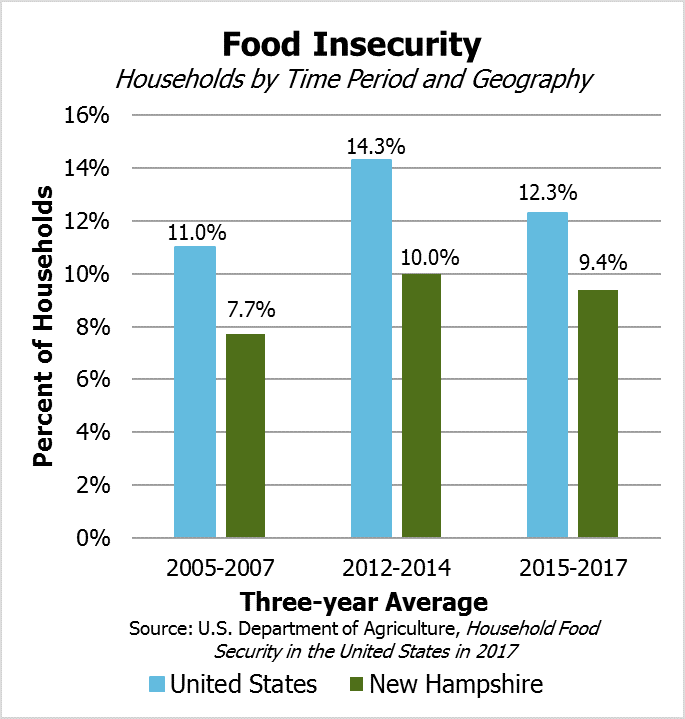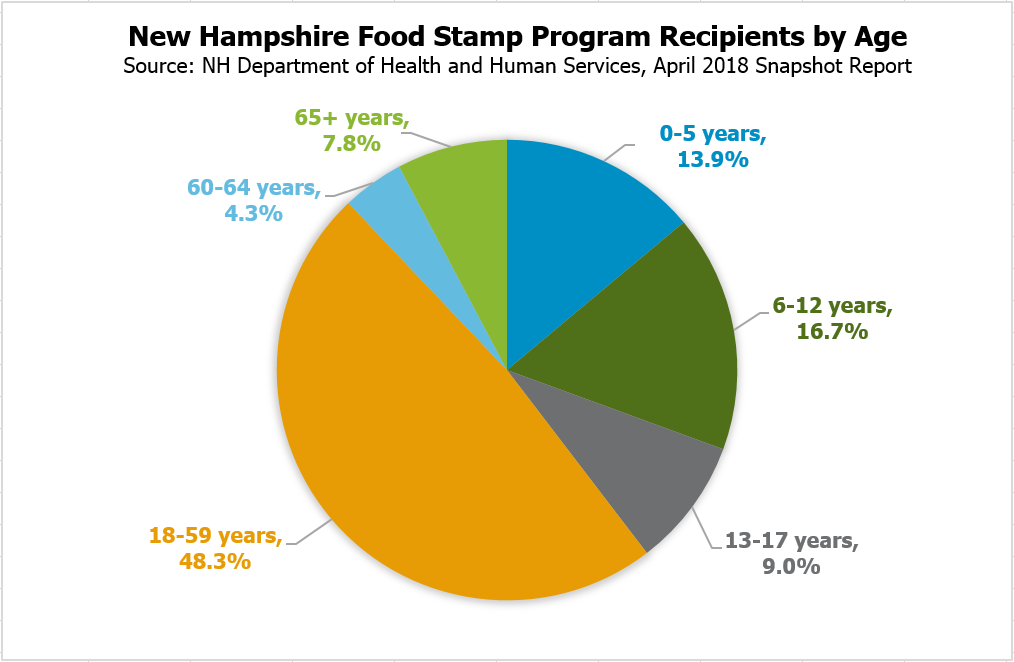A larger percentage of New Hampshire residents had limited access to adequate food due to resource constraints than prior to the Great Recession, according to the most recent estimates from the United States Department of Agriculture. The agency’s report, released this month, showed progress on reducing food insecurity nationally, but New Hampshire has seen a smaller drop in the percentage of food insecure households than the nation as a whole during the economic recovery. While New Hampshire continues to perform better than the nation overall, these estimates suggest the state has not reduced food insecurity following the Recession as quickly as other states, and that the higher levels of economic growth seen in recent years are not reaching everyone.
The data, collected from households through the Current Population Survey using a specific questionnaire to evaluate food insecurity, compares the percentage of all households reporting certain conditions indicating food insecurity within the last year across three-year periods. Three-year periods are necessary at the state level to provide adequate data for statistical sampling, and data for single years are available at the national level.
In New Hampshire, 9.4 percent of households were food insecure in the 2015-2017 period, which represents approximately 50,600 households where a member reported food insecurity within past last year. Although there is a margin of error of about 1.5 percentage points, that represents a statistically significant increase from the 7.7 percent estimated for the 2005-2007 period, before the Recession. There is also not a statistically significant difference from the 10.0 percent estimated for New Hampshire during the 2012-2014 period, when the economy was growing much more slowly overall than the 2015-2017 period in the state. However, there was a decrease in households categorized as having very low food security, a more extreme form of food insecurity determined based on survey responses, between these two time periods.
Nationally, the percentage of households reporting food insecurity was higher in all three periods, and the percentage for 2017 alone was estimated to be 11.8 percent. This percentage includes 15 million households, representing approximately 40 million individuals. About 6.5 million children lived in households where at least one child was food insecure. The national survey data found households with lower incomes, children (especially households with children under age 6), single parents, and headed by non-Hispanic African-American or Hispanic individuals all experienced higher rates of food insecurity than the national average for 2017. Homeless populations were not included in the survey, likely creating a downward bias in the statistics.
Recent decreases in very low food insecurity are encouraging, but do not represent comprehensive alleviation in food insecurity, and food insecurity remains higher than it was prior to the Recession both in New Hampshire and the nation.
One of the primary programs in the state to help alleviate food insecurity is the New Hampshire Food Stamp Program, which is known nationally as the Supplemental Nutrition Assistance Program (SNAP). About 43 percent of households that were food insecure nationally reported receiving SNAP benefits in the 30 days prior to being surveyed in December 2017, including about 46 percent with very low food security. Research suggests enrolling in SNAP helps reduce food insecurity. In New Hampshire, SNAP provided benefits to 83,632 people as of the end of August 2018. All the funding for benefits paid through SNAP in New Hampshire comes from the federal government.
Both chambers of the United States Congress have passed versions of legislation to reauthorize SNAP, but they have notably different provisions. While the U.S. Senate made certain smaller changes to SNAP, the U.S. House bill would change SNAP in ways that would likely lead to thousands of people being disenrolled from SNAP in New Hampshire and increase administrative costs for the state. Among other changes, the U.S. House bill would eliminate eligibility for certain people based on their receipt of assistance through other programs and expand work requirements.
Analysis from the Congressional Budget Office of an earlier but similar version of the House bill noted the elimination of expanded categorical eligibility would reduce enrollment, and children participating in the free- and reduced-price school lunch program due to family SNAP enrollment may also be made ineligible for that program. The Center on Budget and Policy Priorities estimated this change may lead approximately 7,000 individuals in New Hampshire to lose SNAP benefits. The U.S. House bill would also modify and expand a 20 hour per week work or work-related activity requirement existing in SNAP to those with minor children more than five years of age and individuals aged 50 to 59 years old, who are currently exempt. The Center on Budget and Policy Priorities estimated 9,000 New Hampshire adults without disabilities or children under six years old did not work 20 hours per week in a typical month in fiscal year 2016, which would put them at risk of losing SNAP benefits. Individuals in one or both of these groups would be at risk of losing SNAP benefits under the U.S. House bill. The two Congressional chambers will likely vote on a final bill this fall.
With nearly one in ten New Hampshire households facing food insecurity, changes to key support programs such as SNAP have the potential to substantially affect the lives of thousands of Granite Staters. For more information on the New Hampshire Food Stamp Program, see NHFPI’s Fact Sheet.


